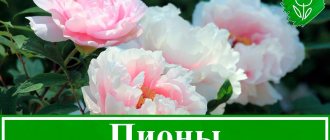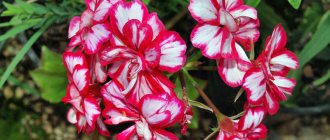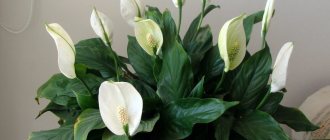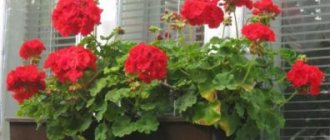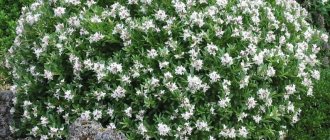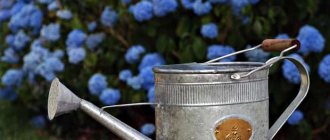Formation of a geranium crown (video)
Spring pruning and pinching perform an important agrotechnical function - they stimulate the formation of new buds, branches and inflorescences.
It is important to remember: after spring pruning and/or pinching, the geranium will bloom later.
The explanation for this is simple: the flower needs time to recuperate. Therefore, you need to decide what you want to achieve: early flowering or its lushness and longevity. If you consider that pinching is a more gentle procedure than pruning, then in the spring you can choose the first option. Young shoots need to be pinched not only in the spring, but also as the plant grows.
Geranium requires constant monitoring by the grower over the growth of shoots and the removal of unnecessary shoots
Unless strictly necessary, pruning in the spring may not be carried out. You can trim only up to 20% of all shoots. Extensive thinning can significantly delay flowering time. Also, the plant may spend all its energy recovering from stress and not bloom at all this season.
Care after work: table
Geraniums that have suffered spring pinching or pruning need the most favorable conditions.
Why do geraniums need a haircut?
Every spring we can see how bushes and trees are trimmed on the central streets of the city, giving them the correct shape. But few people realize that this haircut is not only decorative. Plants are pruned to improve the health and rejuvenation of the crown. The same applies to indoor specimens prone to intensive growth, such as pelargonium (geranium).
Purpose and benefits of pruning
The main purpose of pruning any plant is to thin the crown to improve air exchange, lighting and leaf nutrition. Without this event, the geranium will have a neglected and unhealthy appearance, will stop blooming, and will turn into a shapeless and unkempt bush.
- flowering period is extended;
- more lateral branches and young shoots are formed;
- wintering becomes easier.
metabolism accelerates and its quality improves;
The flowering time of geraniums depends on the variety and occurs from early spring to late autumn, and in some varieties even in winter. In order to have a lot of inflorescences on the plant, it is necessary to prune the bush, but do it correctly and in a timely manner, according to the characteristics of the variety.
To form a beautiful bush and lush color, geraniums need regular pruning.
Autumn pruning is a more logical procedure than spring pruning. From November to February, geraniums begin their dormant period. The plant often slows down its development while continuing to feed. In this state it is very difficult to maintain a lush crown, but cutting it makes wintering much easier. Drastic pruning allows pelargonium to refresh the crown and re-form the bush.
If your pelargonium blooms all year round, then you can cut it at any time.
In winter, geraniums can be trimmed only if there are conditions for maintaining the trimmed flower; at least two lower leaves are left. After the crown of the plant has rejuvenated due to radical pruning, its bush can be formed during the winter by pinching and decorative pruning. Zonal pelargonium has the peculiarity of rapid budding and early formation of buds, so it will only be happy to be trimmed;
- ivy-leaved pelargonium can be cut in both spring and autumn. If the bush becomes excessively elongated during the winter, it is trimmed at the end of February - beginning of March;
- Flower growers cut ampelous geraniums at their own discretion; if the plant does not need pruning, then it is not touched until spring;
- the variegated species is difficult to tolerate autumn pruning; it is easier for them to go through such stress in the spring;
- mini-varieties of geraniums are not cut at all. The crown of these tiny pelargoniums is adjusted only for reasons of beauty and decorativeness of the bush;
- Royal pelargonium is trimmed “under the stump” and placed in a cool place. But such a drastic pruning is not done regularly, but only when necessary, because the plant does not develop as intensively as, for example, zonal geranium.
Photo gallery: geranium varieties
Video: crown formation of geraniums in winter
Reproduction methods
How to propagate geranium? Royal pelargonium is mainly propagated by cuttings. Seeds are used only from store-bought ones. The seeds collected from your plant will sprout, but the flowers will be smaller in size and will lose their characteristic bright color.
Cuttings
Description. To avoid further injury to the plant, cuttings are combined with pruning. Use cut tops with three pairs of leaves. It will not be possible to root royal pelargonium in water - the base of the cutting will rot. Therefore, they are planted directly in the ground.
Procedure
- Before planting, the base of the cuttings is dipped in charcoal powder and dried for several hours.
- Deepen into loose substrate. A mixture of equal amounts of sand and perlite or peat and sand is suitable. In order not to disturb the roots again, it is better to immediately take separate cups. According to some gardeners, it is convenient to use peat tablets.
- After rooting, the cuttings are carefully transplanted into larger diameter pots with nutritious soil. It is better not to rush, to carry out the first transplant in a couple of months.
- Pinch over the third pair of leaves, and repeat pinching as it grows.
The seedlings are watered twice a month with complex fertilizers with a minimum content of nitrogenous substances. Its concentration in the composition should not exceed 10-11%. The first flowering after rooting of the cutting occurs after six to nine months.
Seeds
Description. Growing from seeds is used as a way to simultaneously produce a large number of young plants. Only store-bought seeds are used.
Procedure
- Sowing begins towards the end of winter. Seeds are sown in a light, loose substrate under cover.
- Keep in good lighting, if necessary, supplemented with fluorescent lamps.
- Check the humidity of the substrate daily and remove condensation from the film or glass.
Shoots appear quite quickly - in about two weeks. The germination rate depends on the level of lighting, temperature, and time of seed collection. Fresh seeds germinate much faster. Seedlings can be planted after three or four true leaves appear.
How to form pelargonium in the fall
You can’t just pick up and trim plants. In addition to a certain algorithm of actions, there are rules that are important to follow for the sake of a successful outcome of the event.
Step-by-step instruction
- If geranium is kept in the garden or on the balcony all summer, before autumn pruning it must be brought indoors a couple of weeks before the procedure (in order to give the plant time to get used to the new conditions). If you prune a flower right away, the bush will experience severe stress and get sick without having time to acclimatize.
Pelargonium, accustomed to outdoor maintenance, must be acclimatized indoors before the pruning procedure.
The blade can be treated with any disinfectant
The cut should not be torn
Before radical pruning, you can thin out the bush for convenience.
Also, flower growers often use ordinary brilliant green for disinfection.
It is important to trim a geranium branch above a leaf node, and the cut can be treated with regular green paint
Possible problems in growing
Even the most experienced gardeners are not one hundred percent protected from the problems that arise when growing royal geraniums. It's even more difficult for beginners.
Drops buds and leaves
If the leaves and buds of the royal geranium begin to fall off, then with a high probability we can say that the room is too hot and the air is very dry. Also, these symptoms sometimes indicate insufficient lighting. You will need to turn on the phytolamp, install a humidifier and take measures to reduce the temperature in the room. If the house is cool, then it is enough to limit yourself to additional lighting and monitor the humidity.
Due to the heat, the royal geranium sheds its leaves and buds
The leaves are turning pale
A change in the color of the leaf blade is provoked not only by a deficiency of microelements (in particular nitrogen), but also by a lack of light, as well as excess moisture. It is urgent to analyze these factors and eliminate the cause.
The tips of the leaves are drying out
This problem in royal geranium most often occurs due to moisture deficiency. You should increase the number of waterings and resort to air humidification, but you should not be too zealous.
The lower leaves fall off
The fact that the lower leaves begin to turn yellow and fall off is caused by both a lack of moisture or nutrients in the soil, as well as a lack of light and poor ventilation of the bush. This symptom also signals rotting of the root system, which can lead to the death of the flower.
Pests
The most dangerous pests for royal geraniums are:
- mite;
- weevils;
- whitefly;
- aphid.
Royal geranium is susceptible to pests
To get rid of parasites, you should wipe the inside of the leaf blade with chamomile infusion and leave the plant for a couple of hours, then rinse everything off. If such actions do not bring a positive result, use an insecticide. Step-by-step instructions for its use are contained in the attached documentation.
Other problems
Sometimes the trunk of the royal geranium begins to rot. This indicates that the plant is affected by blackleg. The development of this disease is caused by excessive watering or low temperatures. Sick plants need to be disposed of and the pot disinfected.
Sometimes gardeners wonder why geraniums are green but lethargic? First of all, you should immediately reduce watering. Otherwise, the flower will bleat with gray rot. The scarlet tint of the leaves indicates low temperatures or the presence of drafts.
Pruning geraniums - in autumn, for winter, for lush flowering
Unpretentious geranium is a home flowering plant. For many years it has been popular among indoor plant lovers. These are also beautiful balcony flowers and can often be found on terraces, balconies or garden beds.
They require proper care to grow properly. In addition to fertilizing and watering, the plant needs to be pruned regularly. Pruning geraniums for lush flowering is an important step in care. It prevents stretching, makes the crown fluffy and very beautiful.
Purpose and benefits of pruning
The species diversity of geranium is amazing. She feels great both at home and in open ground conditions. Proper pruning ensures regular flowering with a large number of inflorescences. When starting to form a plant, it is important to know how to prune geraniums correctly and how to form a bush. Detailed answers to these questions are provided below.
Purposes of pinching geraniums:
- activation of lateral branching;
- formation of new inflorescences;
- giving geraniums a beautiful shape;
- ensuring long-term flowering;
- obtaining seedlings for propagation.
Correct and timely pinching of geraniums allows you to activate the lateral vegetative buds. Without outside help they will remain dormant. After pruning pelargonium, the lateral buds begin not only to form new shoots, but also take part in the formation of inflorescence primordia.
When to prune geraniums:
- in spring - the main type of pruning, which is necessary for voluminous flowering;
- in autumn - a preventive procedure to remove dead, diseased and dry parts;
- pinching is a type of pruning that can be done at any time if the need arises.
Important! Geraniums should be pruned regularly to ensure they bloom on time. Otherwise, flowering may be delayed or not occur at all.
Transfer rules
Royal geranium has a very unfavorable attitude towards various movements. Transplantation is carried out in exceptional cases. It is better not to disturb the plant at all. But it happens that you still have to seat them. For example, there may be cases in which the root system has grown so intensely that it simply no longer fits into the pot. In this case, of course, the plant must be replanted.
Transplantation is recommended every 2 years. If this requirement is not met, the plant may stop flowering or there will be a small number of flowers. The optimal time for transplantation is the very beginning of February. The soil should be prepared, which will consist of peat, deciduous soil, turf soil and river sand. Good drainage is essential. Expanded clay or river sand are best suited for this purpose.
Crown formation in winter
The winter months are a dormant time for geraniums. Short daylight hours and lack of solar energy send this indoor flower into hibernation.
- does not bloom;
- does not give active growth;
- does not form new shoots.
As a rule, there is no need for pruning in winter. During this period, you need to monitor the condition of the geranium. Particular attention should be paid to shoots that were pruned in the fall. If the cut areas begin to turn black or rot, then the affected area should be cut off.
If the need arises, the time for the main pruning can be postponed to the second half of February. However, if possible, it is better to postpone this procedure until March.
Before the onset of winter, it is recommended to tame all shoots by at least 1/3. This allows you to activate kidneys that are in an inactive state. This procedure has a beneficial effect on the formation of geraniums.
Conditions of care
The plant places increased demands on its maintenance and cultivation. The emphasis should be placed on four basic rules:
The plant does not tolerate either excess or lack of moisture. It should be protected from direct sun and strong winds. Experienced gardeners do not recommend planting this flower in open ground for the summer. They obviously will not approve of such hardening. But you can take a pot of pelargonium out onto the balcony in the summer. It should be placed on the balcony so that it is not covered by partial shade, but also not exposed to direct sunlight. Otherwise, the plant may get sunburned. The plant does not tolerate conditions in which there is a lack of light. This species cannot live in darkness at all. If there is not enough light, it will stretch out so that it has no strength left to set buds. To get lush buds, the plant must be illuminated with special fluorescent lamps. A certain temperature regime is required. In winter, the temperature should be maintained between 12-15 degrees. The plant will experience discomfort if the room temperature exceeds 24 degrees. The most minimal unpleasant phenomenon will be its lack of flowering.
The extreme negative point would be a complete stop of growth. Due attention should be paid to activities related to watering. How intensively soil moisture is required depends on temperature conditions
In summer, watering should be done moderately and regularly. According to the recommendation of experienced gardeners, watering is not carried out from above, but requires pouring liquid into a tray. With overhead watering, the soil becomes compacted, and royal geranium tolerates this phenomenon very poorly. The water must be defended. A good solution would be to water with rainwater.
The drug Heteroauxin: instructions for use of the solution
If you comply with all these requirements, the plant will certainly reward you with good flowering. It will delight the gardener for a long time with its beautiful, excellent flowers.
How to form pelargonium in the fall?
Houseplant lovers need to know how to prune geraniums in the fall. To get a good result, it is important to strictly follow the pruning rules.
Step-by-step instruction:
- carefully examine the flower - you need to determine which unnecessary parts will be removed;
- all instruments used to make cuts must be disinfected - boiled, calcined or treated with an alcohol solution;
- Before the procedure, you must wash your hands well (preferably with soap) and wear silicone (rubber) gloves. This step is necessary to prevent the risk of infection of the plant through the pinching site;
- remove all dry parts from the plant (old inflorescences, leaves, stems and twigs);
- remove parts that may become a source of disease or have a suspicious appearance;
- remove all stems that are too stretched upward, these include shoots that have more than 5 vegetative buds;
- treat the removal sites with a special disinfectant solution.
Before pruning geraniums in the fall, you need to make sure that this procedure is necessary for it. Not all types of this indoor plant tolerate the removal of its parts well:
- royal geranium responds well to autumn pinching;
- ampelous or variegated ones do not really like this procedure.
Care after autumn pruning
After removing excess parts, the cut area is treated with disinfectants. Suitable:
- coal powder;
- ground cinnamon;
- green solution.
Geranium does not require particularly difficult care after seasonal pruning. It is necessary to monitor the condition of the places where the cut was made. If blackening or rot appears, then repeated removal and disinfection are carried out.
How to prune pelargonium in spring
Spring pruning of pelargonium is aimed at forming a beautiful and voluminous crown with a large number of bright flowers. The deadline for pruning is the last ten days of February - early March.
Purpose and benefits of spring haircut
At the beginning of a new growing season, excess, excessively long shoots are first removed. They spoil the aesthetics of the plant and do not produce the desired flowering.
In spring, a beautiful pelargonium bush is formed, which will delight you with beautiful flowering throughout the summer.
Important! It is recommended to carry out spring pruning as early as possible; the timing of its implementation depends on when the generative (flower) buds begin to form.
Step-by-step instructions for spring pruning
- prepare equipment and tools for the procedure - scissors, pruners, knife;
- sterilize instruments;
- wash and sanitize your hands, put on gloves;
- examine the plant from all sides and determine the direction of work;
- remove dry parts of the plant - branches and leaves;
- select the main stem of the plant, remove the lower young shoots from it;
- remove all lateral shoots and other stems, leaving only the main one;
- the top of the central stem must be pinched to activate branching;
- treat the sites where plant parts are removed with antiseptic preparations (charcoal powder, brilliant green, ground cinnamon).
Important! It is necessary to pinch the indoor plant correctly to form a tree-like form.
Care after spring pruning
After the crown of this plant has formed, it is important to provide it with proper care. It will speed up the processes of growth and the beginning of flowering.
- watering once every 3 days;
- protection from cold and drafts;
- fertilizing with mineral fertilizers once every 30 days.
How to form a fluffy pelargonium bush, the essence of pinching
How to pinch geraniums so that they grow thicker and if the plant stretches out, what should you do? These questions are often asked by geranium growers.
Pinching is the removal of the apical growth point of a houseplant. If the geranium does not have the opportunity to grow upward, it will begin to actively develop lateral shoots and branches. This will allow you to form a beautiful and lush crown.
The form of pelargonium in which one main stem with a voluminous crown develops is called standard.
To create such an unusual appearance you need:
- remove additional stems and extra side branches;
- regularly inspect the plant for the formation of excess parts and remove them in a timely manner.
The pinching technique is used for plants that have just begun to grow. Regular removal of apical growth points ensures the appearance of a beautiful spherical crown.
general characteristics
Anyone who decides to seriously engage in this type of flowers will have to work hard, otherwise the expected result simply will not happen.
Truly “royal blood” actually flows in the stems and leaves of this type of geranium. Its homeland is South America, but this plant appeared in Europe only in the 8th century. It so happened that royal geranium achieved enormous popularity among flower growers in the shortest possible time. This plant is extremely interesting for breeders. As a result of their hard work, which does not stop literally for a minute, new varieties of royal pelargonium appear. Currently, there are such a large number of its varieties that it is quite difficult to name the exact number.
At home, pelargonium can reach a height of 60−80 cm. It is not worth growing bushes with a higher height, because the flowers are located only at the very top of the plant. If geranium grows to a height of 1 m, then it is characterized by the loss of all decorative properties. If you pursue only experimental goals, you can try to grow a bush up to 1.5 m high. Surrounded by low-growing plants, all the contrasting features will fully manifest themselves.
The most common mistakes when pruning
Geraniums can be pruned incorrectly and the plant may become sick or even die. Most often, inexperienced plant growers make the following mistakes:
- the plant is pruned at the wrong time;
- non-compliance with the recommendation on the height of the cut relative to the vegetative node;
- excessive removal of shoot parts;
- Too frequent pruning.
As a result of these actions, the plant may stop blooming, acquire an unsightly appearance, and also become ill or die.
In addition, many owners of pelargonium feed the plant incorrectly.
Proper feeding includes:
- immediately after pruning, it is recommended to feed geraniums with nitrogen mineral fertilizers;
- At the stage of active flowering and the appearance of a lush crown, the need for potassium increases.
Conclusion
Geranium or pelargonium is rightfully valued by indoor plant lovers and gardeners. Correct and timely pruning will help create a crown of amazing beauty. The plant will delight you with abundant flowering every season. The procedure for removing excess parts is simple, but you must follow some rules. They will help you avoid mistakes that have an extremely negative impact on the condition of the plant.
Features of pruning royal geraniums
For full flowering of the plant, it is necessary to do annual pruning. It is produced in spring or autumn, depending on the variety and living conditions of the flower.
Which shoots need to be removed or shortened often depends on the desired shape. But there are also general rules for pruning indoor plants.
Since geraniums bloom all summer, it is better to prune them in the fall, preparing the plant for rest. The process carried out on time will be healing and will ensure long and abundant flowering next year.
The procedure is carried out after the flowers have completely withered. Most likely, pelargonium will completely fade before November.
Therefore, pruning must be done before the beginning of the first earthly month, after which the flower goes to rest and cannot be disturbed.
For trimming you will need:
- stationery knife or blade;
- Activated carbon;
- phosphorus fertilizers.
If you have a small and neat bush, then pruning will consist only of removing wilted leaves and weak side shoots.
